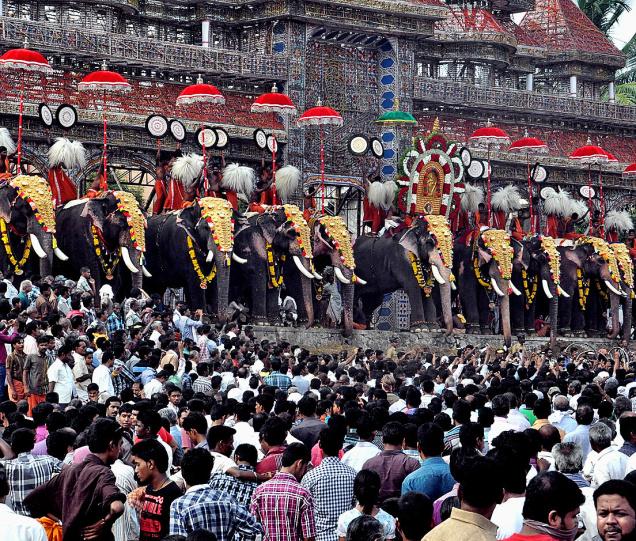Nenmara-Vallangi Vela 2016

Nenmara Vallangi Vela
If Nenmara and Vallangi are on the tourism map of Kerala, it is because of the temple festival called Nenmara-Vallangi Vela. Nenmara and Vallangi are two deshams (counties) in the Palakkad district of Kerala. The Vela is the annual festival celebrated by these two neighboring counties at the Nellikulangara Bhagavathy Temple. The friendly rivalry between them is what keeps this festival so interesting.
Temple festivals in Kerala always begin with the traditional flag hoisting ceremony called Kodiyettam. While most festivals are 10 day affairs, the Nenmara-Vallangi Vela is celebrated over 20 days. The whole region plunges into the festive mood during these days. The biggest highlight of this festival is the elephant pageant. As many as 30 festooned elephants assemble under a decorated canopy. The other two festivals famous for their elephant pageants are Thrissur Pooram and Chinakkathoor Pooram.
When – April 2, 2016
Nenmara Vallangi Vela is celebrated on the 20th day of the Malayalam month of Meenam. This year it falls on April 2nd. It is one of the most anticipated events in the festival calendar of Kerala. Lakhs of people participate in this Vela each year.
The people of both counties want their processions to be the most pompous. Magnificent fireworks and the percussion orchestra are other major attractions. Nenmara will start their procession from a temple in their village and Vallangi will start their procession from a Temple in their village. They will both assemble at the Nellikkulangara Bhagavathi Temple.

Festooned elephants standing in front of a decorated canopy – a scene from Nenmara Vallangi Vela
The festivities start on the 1st of Meenam. On this day representatives of both villages will meet at the Nellikulangara Temple to discuss the formalities. A Kalam (the drawing of Bhagavathi using powders) is made and with the permission of the people of both villages, the festival flag is hoisted.
Kalam Puja and Kalam Paatu are then performed for 21 days. The festival is on the 20th day. Kalam Paatu involves the singing of songs praising Bhagavathi (Goddess). From the 9th day, Kummatti, a ritual art form, will be staged. Kummatti performance will be continued up to the 17th day.
On the 18th day, there will be Kari Vela. Performers of Kari Vela have black powder smeared over their body. They are said to represent Goddess Kali (she is dark) and the Bhoota Gana (Shiva’s disciples). This festival is a celebration of the victory of Goddess Kali over the demon Darikan. Kari Vela is performed by four groups. They will start from their respective places and perform in front of all Nair homes. Nairs are a Kshatriya clan and perhaps the most influential Hindu community in Kerala.
By midnight, the Kari Velas will reach the Vetaikorumakan Temple. Andivela, another folk dance form, is performed on the night of the 19th day of the festival. That night the sword and ‘Chilambu’ of the Goddess is taken out in a procession from ‘Mannam’ to the “Vetaikorumakan” Temple accompanied by three elephants and ‘Melam’ (traditional orchestra). The same night, the elephants used in the festival are auctioned. The winner of the auction can start the elephant procession (Ezhunnallathu) from their home.
The Nenmara Vallangi Vela is on the 20th of Meenam. Each desam will start their Vela (procession) from their respective Mannam. The first ceremony is Thidambu (replica of the Goddess) Puja. Panchavavdhyam (percussion orchestra) starts at about 11.30 AM. Meanwhile the festooned elephants get ready for the Thidambu Kayattal function. The idol of the Goddess is mounted on the elephant standing in the middle of the lineup and the devotees will pray to her to make the festival a grand success without any loss of life or other disasters. The processions of both counties will then start moving towards the Nellikkulangara Temple.
One of the major attractions of this festival is the Pandal or decorated canopy. The Pandal is illuminated with numerous lights. The elephants assemble in front of this pandal and the Kudamattam (the changing of parasols held over the elephants) ceremony begins. The parasols are changed numerous times and their color and beauty enchant the viewers. The elephants will then pay homage to the Goddess and leave. Soon after this, the fireworks start.